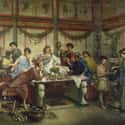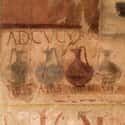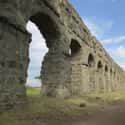-
(#7) One Scholar Suggests 19 Roman Emperors May Have Experienced Lead Exposure
When Jerome Nriagu began to research lead exposure in ancient Rome, he examined the diets of over two dozen Roman emperors from 30 BCE to 220 CE. Based on his research, Nriagu found evidence that 19 emperors "had a predilection to the lead-tainted" wine and food sweetened with sapa.
Nriagu concluded that multiple emperors almost certainly suffered from lead exposure. The widespread problem may have even weakened the empire.
-
(#1) Ancient Romans Added Sapa To Food And Drinks
The Romans were known for their feasts. Rich Romans showed off their wealth by hosting elaborate dinner parties. But sapa, used to sweeten foods, contained a toxic amount of lead.
Romans made sapa by boiling mashed grapes down into a thick syrup. The syrup itself wasn't the problem - the Romans cooked sapa in lead pots, and the toxic substance bled into the sweet syrup. While elite Romans used sapa to make their food taste better, they slowly harmed themselves.
-
(#2) Romans Preserved Wine With The Toxic Sweetener
Sapa was used for more than sweetening foods. It was also used extensively in the wine industry. Romans preserved wine with sapa, incidentally infusing the drink with lead. The Romans had a reputation for drinking - the average Roman drank a liter of wine each day. That's around 100 gallons of wine each year.
And elite Romans drank even more heavily. The Roman emperor Elgabalus was rumored to drink wine from a swimming pool.
-
(#13) Roman Water Had 100 Times The Lead Content Of Spring Water
After traveling through lead pipes, ancient Rome's water supply became contaminated with lead. In fact, researchers recently estimated that Rome's waters contained 100 times the lead levels of local spring waters. Scientists came to this conclusion by comparing sediments from local ports with traces of water found in ancient Roman piping.
Did the contaminated water hurt Rome? Researchers believe the levels were too low to cause significant harm. Still, drinking water contaminated with any amount of lead can be problematic.
-
(#11) Pliny The Elder Wrote A Recipe For Sapa That You Can Still Use Today
Pliny the Elder detailed how to make sapa in the 1st century CE. "Sapa is a product of art, not of nature," Pliny began, "made by boiling down [grape] must to a third of its quantity." Sapa was different from defrutum, Pliny explained, in that sapa was more concentrated. Defrutum was grape juice boiled to one half its volume.
The reduction made sapa much sweeter than grape juice. And the Romans knew that boiling it in lead pots increased the sweetness. While the simple Roman recipe still works to create sapa, today we know not to boil the syrup in lead pots. Sapa, on its own, is safe to consume; it only becomes toxic when it's heated in a lead vessel.
-
(#10) A Roman Cookbook Contained Nearly 100 Lead-Filled Recipes
Romans didn't just use sapa to preserve wine. They also used lead acetate, or sugar of lead, to sweeten their food. A 4th-century Roman recipe book, the Apicius, included nearly 100 recipes with lead acetate.
Ironically, one side effect of lead contamination might have pushed Romans to use more of the sweetener. Lead exposure can cause a metallic taste in the mouth, which might have encouraged Romans to turn to sweetened wine or food.
New Random Displays Display All By Ranking
About This Tool
Artificial sweeteners are a class of synthetic or semi-synthetic organic compounds that are widely used as substitutes for sucrose in foods, beverages, drugs and personal care products, so it’s called calorie-free sugar. In recent years, artificial sweeteners are also widely used in animal feed to improve the taste of feed. The first artificial sweetener to be used by humans was Saccharin, which he discovered by accident in 1897 while refining a new preservative from coal tar. SACCHARIN was the only artificial sweetener used in the United States between 1890 and 1930, and was used only in people with diabetes. With the improvement of people’s living standard, the problem of obesity has been paid more attention, which has accelerated the emergence and wider use of artificial sweeteners.
The random generator tool collates 14 items to document Roman times when people were poisoned by artificial sweeteners. Here, you can find events you’ve never heard Of before, such as Ancient Romans Added Sapa To Food And Drinks, SAPA Is Called Sugar Of Lead’, a Single tear Of SAPA Was Dangerous, Romans intended Lead Pots For a sweeper
Our data comes from Ranker, If you want to participate in the ranking of items displayed on this page, please click here.
















